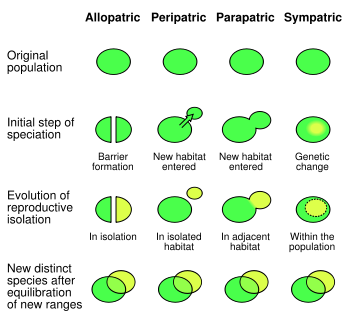Allopatric speciation

Allopatric speciation, also known as geographic speciation, is the phenomenon whereby biological populations are physically isolated by an extrinsic barrier and evolve intrinsic (genetic) reproductive isolation, such that if the barrier breaks down, individuals of the populations can no longer interbreed. Evolutionary biologists agree that allopatry is a common method by which new species arise. (The word is derived from the ancient Greek allos, "other" + Greek patrā, "fatherland".) By contrast, the frequency of other types of speciation, such as sympatric speciation, parapatric speciation, and heteropatric speciation, is debated.
Evolution of reproductive isolation is generally thought to be an incidental by-product of genetic divergence of other traits, particularly adaptive changes that evolve through natural selection in response to different environmental conditions in separate geographic areas. Ernst Mayr, an evolutionary biologist and famous proponent of allopatric speciation, hypothesized that adaptive genetic changes that accumulate between allopatric populations cause negative epistasis in hybrids, resulting in sterility or inviability.
Allopatric speciation may occur when a species is subdivided into two large populations (dichopatric or vicariant speciation), or when a small number of individuals colonize a novel habitat on the periphery of a species' geographic range (peripatric speciation). Because natural selection is a powerful evolutionary force in large populations, adaptive evolution likely causes the genetic changes that results in reproductive isolation in vicariant speciation. In peripatric speciation, however, the genetic changes that are thought to occur within the peripheral isolate are more controversial.
Proponents of peripatric speciation contend that small population size in the peripheral isolate (sometimes referred to as a "splinter population") allows genetic drift, which can be a more powerful force than natural selection in small populations, to deconstruct complex genotypes, allowing the creation of novel gene combinations. Both forms need not be mutually exclusive; in practice, passive isolation or fragmentation as well as active dispersal seem to play a role in many cases of speciation.
A famous example of allopatric speciation is that of Charles Darwin's Galápagos Finches, another one involves the Asian Elephant[1].
References
- ↑ Fickel, J. (2007). "Distribution of haplotypes and microsatellite alleles among Asian elephants (Elephas maximus) in Thailand" (PDF). European Journal of Wildlife Research. 53 (4): 298–303. Retrieved 2008-04-14. Unknown parameter
|coauthors=ignored (help)
da:Allopatri de:Allopatrische Artbildung nl:Allopatrische soortvorming no:Allopatri fi:Allopatrinen lajiutuminen